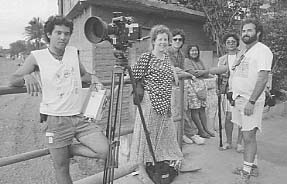Dashiell Hammett's 1929 novel "The Maltese Falcon" was turned into three films in one decade: Roy Del Ruth's 1931
The Maltese Falcon (later retitled
Dangerous Woman), William Dieterle's 1936
Satan Met a Lady and John Huston's 1941
The Maltese Falcon.
****

The 1931 version plays much like Roy Del Ruth's other pre-Code gems, such as 1930's
Lady Killer with James Cagney: the sensation of comedy and cruelty, with an unmistakable affection for the sleazy and the lurid. An abridged version of the novel, private dick Sam Spade is still the protagonist (though Del Ruth really emphasizes the "public" over the "private"). After his partner is killed on a case, Spade is drawn into a free-for-all over a mystery jeweled falcon--femme fatales, young gunmen, exotic foreigners, fat old men and the coppers--the film is everything film noir would come to be, but The Maltese Falcon is not quite there yet. It is not as dark or cynical as 1940s harboiled films would be; instead, there is a certain lightness about this
Maltese Falcon--perhaps its the way that Spade (played by Ricardo Cortez) always has this conniving grin on his face, and can't say anything straight. Duplicity does not expose the darker side of humanity, but the funnier side of things: with no one telling the truth, any absurdity can pass through someone's mouth. It's almost the aesthetic of a Marx Brothers film, but without the slapstick action.
***
 Satan Met a Lady
Satan Met a Lady, too, feels like a Marx Brothers film--but not in a good way. It feels like the "straight" scenes, the little bits of plot that try and form a cohesive action, but utterly fail dramatically. Satan, however, has none of the comic relief of a Groucho, nor the sarcasm of Roy Del Ruth's 1931 adaptation. The plot retains the core of the story, but with some excess baggage, such as Spade being an exiled detective, run out of every town by various "public morality groups." The story, however, is so streamlined (to make room for new additions), that in its 76 minutes it hardly finds time to cohere. Duplicity is never so much an issue as unbelievablity: the acting is not convincing of anything but a poor script.
 Sound is to Pabst what a tack is to a bicycle tire: it still runs, but the ride is bumpy and it takes too long to get there. G.W. Pabst's The Threepenny Opera was filmed in 1931 when sound recording techniques still had much to be desired, and much of the film's failing has to do with just that. Lacking the freedom that camera's were allowed in the silent era (when microphones were not an issue), Pabst reverts to tableaux shots and long takes: the scenes are static, and the actors hardly move. This isn't the usual Pabst who constructs his stories in lurid, penetrating close-ups. What he is able to carry over from his silent films are his love of decor and stylized sets. The acting, however, is uninspired, and it's as though the actors are reading the lines to themselves before they go to sleep. Just as their movements are static, there is nothing kinetic about their voices. As many early sound pictures proved, movies may have learned to talk, but they had still to learn how to move once again.
Sound is to Pabst what a tack is to a bicycle tire: it still runs, but the ride is bumpy and it takes too long to get there. G.W. Pabst's The Threepenny Opera was filmed in 1931 when sound recording techniques still had much to be desired, and much of the film's failing has to do with just that. Lacking the freedom that camera's were allowed in the silent era (when microphones were not an issue), Pabst reverts to tableaux shots and long takes: the scenes are static, and the actors hardly move. This isn't the usual Pabst who constructs his stories in lurid, penetrating close-ups. What he is able to carry over from his silent films are his love of decor and stylized sets. The acting, however, is uninspired, and it's as though the actors are reading the lines to themselves before they go to sleep. Just as their movements are static, there is nothing kinetic about their voices. As many early sound pictures proved, movies may have learned to talk, but they had still to learn how to move once again.







